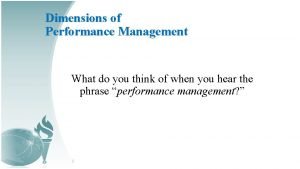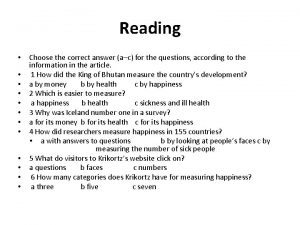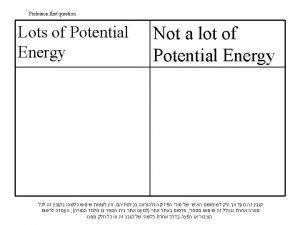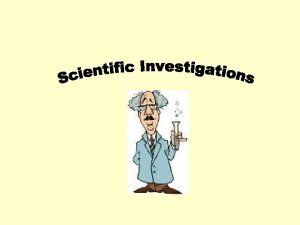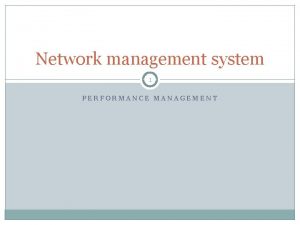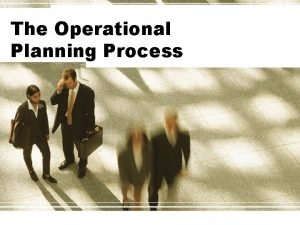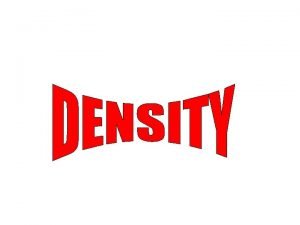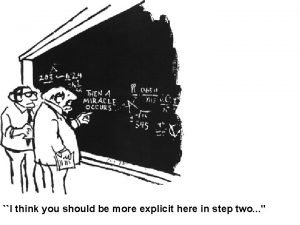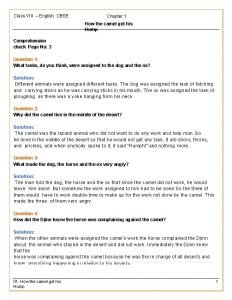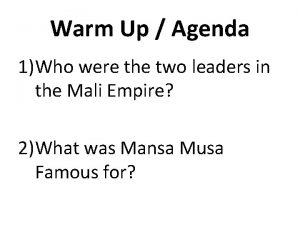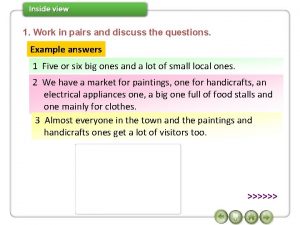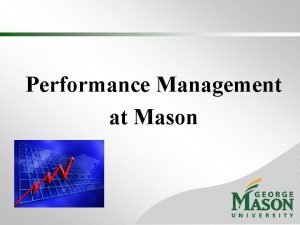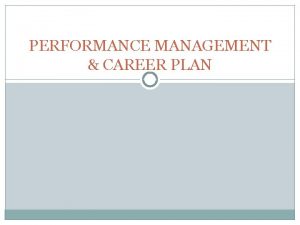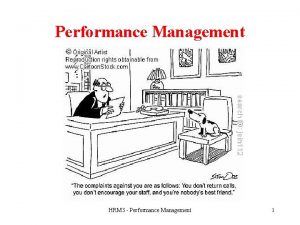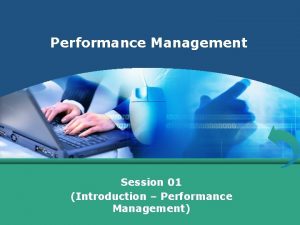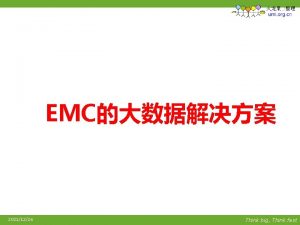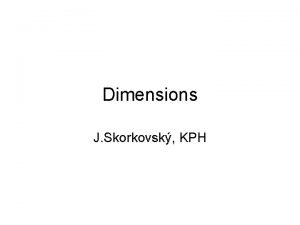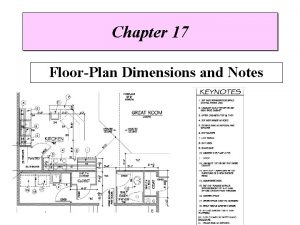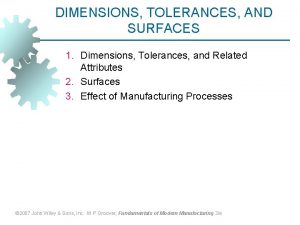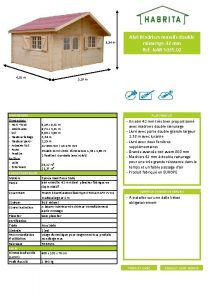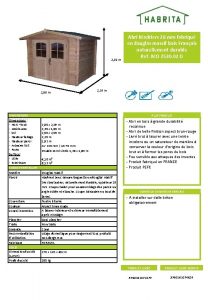Dimensions of Performance Management What do you think

























































- Slides: 57

Dimensions of Performance Management What do you think of when you hear the phrase “performance management? ” 1

Moving Toward Excellence

Total Performance Management STRATEGY Goals Discipline & Performance Improvement Processes KPI Alignment & Cascading CULTURE Goals Setting - Planning Performance Appraisal System - Evaluation Processes Rewards & Recognition Tasks Career Planning & Development Human Performance Architecture Individual Employee Performance Management Competency Training & Development Coaching Systems Feedback Systems incl 360 Systems Ranking/ Rating Distribution Systems Mentoring Systems HPO – High Performance Organization Results/ Value – Employees/ Partners/ Customers/ Shareholders/ Community Values Practices Behaviors

Getting Answers Requires Integration Who are our top performers? How can we hire/develop/retain people like them? ü ü ü Are we retaining the best workers? Where did they come from? ü ü ü Do workers have the skills needed to achieve performance goals? ü ü ü

Fast Time Leadership

Fast Time Leadership

Activity on Performance Management • Let’s spend a moment as a large group to discuss performance management • How do your organizations handle performance management? Could I have someone volunteer to describe how your organization’s performance management system works? • How are issues having to do with promotability (that is, potential) handled as part of performance management? Not handled? Does the issue come up or not?

Why Do Organization’s Sponsor Performance Management Programs, and What Results Are Sought from Them? Performance management systems can help to: • Clarify performance targets • Create incentives for performance • Establish individual development plans • Measure desired results • Reward individuals or teams for results achieved • What other purposes can be served by performance management systems?

The Traditional Performance Management System

An Improved Performance Management System

Why Are Performance Management Programs Important for Talent Management? • Individuals should not be promoted solely because they have a track records of doing good jobs and receiving good performance ratings because promotion decisions should be based on how well individuals are perceived to be able to do work at a higher level of responsibility • By the same token, individuals should not be promoted if they are failing their current jobs and/or not receiving good performance ratings because that will destroy the credibility of the promotion system

Why Do Organization’s Sponsor Performance Management Programs, and What Results Are Sought from Them? Objectives of Performance Management System Average Rank Provide information to employees about their performance Clarify organizational expectations of employees Identify developmental needs Gather information for pay decisions Gather information for coaching Document performance for employee records Gather information for promotion & development decisions 2. 8 3. 7 4. 0 4. 2 4. 6 5. 2 Source: SHRM/PDI. (2000). Performance management survey.

Why Is Performance Management Important for Talent Management and Development? Performance management is essential to talent management and development because: • Investments in talent management should only be made with those who are succeeding in their current jobs • Performance management provides an objective means by which to assess and reward current performance/productivity



Definitions of Performance Appraisal Performance appraisal provides an annual review and evaluation of an individual's job performance (Eastern Illinois University, 2009) Performance appraisal is the process of determining how well employees do their jobs compared with a set of standards and communicating that information to those employees (Chukwuba, 2011) It provides a justification for human resource decision such as rewards, career planning, transfers, training, counseling, mentoring , termination, etc. Chattopadhayay and Ghosh (2012),

When Performance Appraisal? Annually • Many organization usually make an evaluation of the employees’ performance in the end of the year. • annual employee performance reviews appear to be the standard in most American organizations. Semiannually • A semi-annual one for the employee to discuss with his manager any needed remedial steps for his performance on an unofficial basis. While the second one, would be an official one held at the end of the year for the employee to receive his appraisal results and know about the salary increase or promotion. E. g: Japan Others • According to the Chartered Institute of Personnel and Development (CIPD), UK, 87% of employers use some form of individual annual appraisals, 27% do them twice a year and 10% more often that. Some use them when projects come to an end.

Performance Appraisal Steps Step l: The Initial (Performance) Planning Session • Meeting individually to described expectation Step II: The Mid. Point Review • provide feedback to the employee during the primary performance period Step III: The Final Review Session • to review and rate the performance of each employee during the entire performance rating period. (West Virginia Division of Personnel Handbook, 2005)

Performance Evaluation Steps 1. Establish performance standards for each position and criteria for evaluation. 6. Make decisions and file evaluation. 2. Establish performance evaluation policies on when to rate, how often to rate, and who should rate. 3. Have raters gather data on employees’ performance. 5. Discuss the evaluation with the employees. 4. Have raters (and employees in some systems) evaluate employees’ performance. (Kumari, 2012)

PERFORMANCE APPRAISAL METHODS

Traditional vs. New Approach Traditional Approach • This method is based on studying the personal qualities of the employees. It may include knowledge, initiative, loyalty, leadership and judgment (Aggarwal & Thakur, 2013). New Approach • Performance appraisal is used for developmental and motivational purposes in the organizations (Gürbüz & Dikmenli, 2007).

(Nili, Ardakani & Shekarchizadeh, 2012)

Methods and Form SHRM Curriculum Guidebook (2010)

Critical Incident Method • Keeping a record of uncommonly good or undesirable examples of an employee's work related behavior and reviewing it with the employee at predetermined times.

Management by Objectives (MBO) • Employees are evaluated how well they accomplished a specific set of objectives that have been determined to critical in the successful completion of the job.

Narrative Essay • Evaluator writes an explanation about employee’s strength and weakness points, previous performance, positional and suggestion for his (her) improvement at the end of evaluation time.

Rating Scale Behaviorally Anchored Rating Scale (BARS) Graphic Rating Scale • BARS combines elements from critical incident and graphic rating scale approaches. The supervisor rates employees’ according to items on a numerical scale. • A scale that lists a number of traits and a range of performance for each, the employee is then rated by identifying the score that best describes his or her performance for each trait.


Comparative Methods • Comparative methods of performance appraisal seek to identify one worker’s standing to others. • Ranking, paired comparison, and forced distribution

Comparative Methods Ranking Method Forced Distribution Ranking Paired - employees from Comparison - This method forces a best to worst on a - Each person is set percentage of all particular trait, person being directly compared choosing highest, evaluated into prethen lowest, until with every other determined person being rated. performance all ranked categories (Aggarwal & Thakur, 2013)

360 Feedback • Is known by a variety of names, including multisource assessment, 360 -degree feedback, multirater assessment, and three-dimensional or full-circle appraisal. • It relies on the input of an employee's superior, colleagues, subordinates, sometimes customers, suppliers and/or spouses. • The information collected and feedback is provided in full circular fashion top down and back to top.

Supervisors • Supervisor: • Best position to evaluate performance in relation to strategic organization goals Peers • Peer: • Must know the level of performance of the employee being evaluated. • May be useful when the task of the work unit require frequent working contact among peers Subordinates • For developmental aspects of performance evaluation • Subordinates are a valuable source of information regarding particular aspects of a supervisor or leader’s performance such as communication, team building or delegation. • For example Exxon and universities

Self Customers • Self appraisal • To be used for developmental aspects. • Self evaluation have often been met with skepticism by organizations because the self interest of the employee. • Customers • Useful for jobs that require a high degree of interaction with public or with particular jobrelated individuals. • Clients • May also offer a different perspective on a employee’s performance, particularly for jobs that require a high degree of interaction with people. For example, client appraisals can be a valuable source of feedback regarding the quality of service provision (e. g. the quality of interaction, degree of professionalism). • Group Calibration

Components in Appraisal Form • • • Basic employee information Accountabilities, objectives and standard Competencies and indicators Major achievements and contributions Developmental achievements Developmental needs, plans, and goals Stakeholder input Employees comments Signature (Aguinis, 2009)

APPRAISER ERROR

Appraisal Error • Appraisal error affect the objectivity of the appraisal negatively (Boachie. Mensah & Seidu, 2012). • The problems that affect the validity and dependability of the Performance appraisal systems (Kumari, 2012)

Component of Appraisal Error (Kumari, 2012) Judgment Error • People commit mistake due to biasness and inadequate training while evaluating people and their performance. • These errors are also called as Rater Errors. Poor Appraisal Forms • The rating scale may be quite vague and unclear. • Problems with evaluation standards • The rating form may ignore important aspects of job performance. • The forms may be too long and complex. Ineffective Organizational Policies and Practices • Very often the sincere appraisal report put in by a rater is not suitably rewarded

Ratings Error • Unintentionally • Intentional • • • Leniency • Severity • Central tendency Similar to me Contrast Halo Primacy Recency Negatively First impression Spillover Stereotype Attribution (Aguinis, 2009)

Key Performance Indicators (KPIs) • Is a quantifiable measure an enterprise uses to determine how well it meets its set operational and strategic goals • Hence critically linked to CSFs (Critical Success Factors) and KRAs (Key Result Areas) • Different businesses can have different KPIs depending on their respective performance criteria priorities, i. e. it is dynamic • At same time, the indicators usually follow industry wide bench marks, standards • All KPIs are performance metrics (goals) but not all performance metrics (goals) are KPIs

Key Performance Questions (KPQs) CEO Key Inquiry & Insights …. • KPQ 1: Why do we need to be high performing? • KPQ 2: What is high performance for PV Drilling? • KPQ 3: How would we know if and when we are high performing? What does success look like? • KPQ 4: According to whom are we high performing? Shareholders? Customers? Employees? Business Partners? • KPQ 5: Are we doing the right “what? ” • Strategic vs Operational • Financial vs Non Financial • KPQ 6: What are the VITAL FEW key performance metrics? • KPQ 7: Is high performance pervasive in all areas and all levels of the enterprise?

KPI – Identifying & Focusing on Executing Vital Few Targets “What gets measured, gets managed. When you measure the wrong things, little wonder you get the wrong results. When you measure insignificant things, little wonder you get insignificant results. ”

KPIs & Goal Setting 3 Challenges 1) SET IT RIGHT to GET IT RIGHT If the organization plans it wrong, we get the best wrong execution!! If the organization measures the right vital few, it gets the right results transformation!! 2) CASCADE & ALIGN IT RIGHT to GET ACCOUNTABILITY & COLLABORATION RIGHT All employees at all functions and all hierarchy have clear line of sight of how their goals align to the corporate goals!! All functions are clear on how their measures of success contribute to the success of another function!! 3) CASCADES risks dilution & fragmentation, reverse review for RIGHT ALIGNMENT The sum of all the goals must equal to the desired results of the corporate objectives!! Performance systems are as strong or as weak as its weakest link!!

KPI - SET IT RIGHT to GET IT RIGHT If the organization plans it wrong, we get the best wrong execution!! If the organization measures the right vital few, it gets the right results transformation!!

KPI Types … Operational Metrics & Targets • • • Annual (Business) Plan Oriented Quantitative Measures – The What, The When Efficiency Measures Each measure stands on its own merits – “Cascade” sensitive Incremental Improvements or Performance Integrity Air Plane Cockpit Displays (Real-time measurement) Strategic KPI Metrics & Targets • • • Long Range (Strategic) Plan Oriented Quantitative & Project Measures Effectiveness Measures Transformational or Break Through Performance Strong inter-links between every measure – “Catch-Ball” & “Alignment-Collaboration” sensitive • Bowling Score Displays (Get the sense • Requires PDCA (Plan Do Check Act) Measures – The Why, The What, The How

Types of KPIs Process KPIs - measure the efficiency or productivity of a business process. Examples - Days to deliver an order. Input KPIs - measure assets and resources invested in or used to generate business results. Examples - Dollars spent on research and development, Funding for employee training, Quality of raw materials.

Types of KPIs Output KPIs - measure the financial and nonfinancial results of business activities. Examples - Revenues, Number of new customers acquired. Leading KPIs - measure activities that have a significant effect on future performance. Drive the performance of the outcome measure, being predictor of success or failure.

Types of KPIs Lagging KPI - is a type of indicator that reflect the success or failure after an event has been consumed. Such as most financial KPIs, measure the output of past activity. Outcome KPI - Reflects overall results or impact of the business activity in terms of generated benefits, as a quantification of performance. Examples are customer retention, brand awareness.

Types of KPIs Qualitative KPI - A descriptive characteristic, an opinion, a property or a trait. Examples are employee satisfaction through surveys which gives a qualitative report. Quantitative KPI - A measurable characteristic, resulted by counting, adding, or averaging numbers. Quantitative data is most common in measurement and therefore forms the backbone of most KPIs. Examples are Units per man-hour.

“SET SMART” KPIs S – Does it “SCARE” the competition E – Does it “ENGAGE” the employees T – Does it “THRILL” the customers S – Specific, Significant M – Measurable, Motivational A – Actionable, Aligned R – Relevant, Rewarding T – Timely, Tangible

Combining 2 Proven Methods for KPI - Hoshin Kanri & Balanced Scorecards Hoshin Kanri Balanced Score Card Defined Excellent Process Drives Excellent Outputs Defined Excellent Outputs Drives Excellent Process (maybe) Painstaking characterization of business drivers and processes before articulating KPIs Audacious , aggressive goal setting tied to KPIs and prescribed 4 standard business drivers Process allows for “catch ball” and negotiating alternatives Process uses cascading through “tell”

Balanced Score Card – Generic

Standard Balanced Score Card Dimensions – GOOD START but needs deeper dive … Score Card Dimension Areas • Finance • Return On Investment Cash Flow Return on Capital Employed Financial Results (Quarterly/Yearly) • Number of activities per function Duplicate activities across functions Process alignment (is the right process in the right department? ) Process bottlenecks Process automation • Is there the correct level of expertise for the job? Employee turnover Job satisfaction Training/Learning opportunities • Delivery performance to customer Quality performance for customer Customer satisfaction rate Customer percentage of market Customer retention rate • Internal Business Processes • Learning & Growth • Customer

Critical Success Factors (CSFs) • Elements that are vital for an enterprise to be successful • Drives the enterprise’s strategy forward, it makes or breaks the success of the strategy • Answers the questions: “Why would customers choose us? ” • Can become a distinctive competitive differentiator/ advantage

Critical Success Factors (CSFs) • CSFs are determined by THE INDUSTRY factors resulting from specific industry characteristics; these are things that the organization must do to remain competitive within that industry THE ENVIRONMENT – factors resulting from macro-environmental influences on an organization e. g. the economy, competitors, technology, etc. THE STRATEGY – factors resulting from the specific competitive strategy chosen by the organization; the way in which the company chooses to position themselves, market themselves, e. g. high or low volume, high end or low end, etc. TEMPORAL – factors resulting from the organization’s internal forces, challenges, directions and influences e. g. talent profile and leadership culture

Exercise in CSF Step 1. Brainstorm the list of CSFs for PV Drilling - Industry Driven - Environmental Driven - Strategy Driven - Temporal Driven Step 2. Rank Order the CSFs (with interlinkages noted) Step 3. For the “enterprise level” pick out the TOP 5 CSFs

Definition of “INSANITY”? INSANITY

Other Challenges • Weightage of KPIs • Cadence of Reviews • Visual Management & Review Templates
 Dream with eyes open
Dream with eyes open If you think you can you can poem
If you think you can you can poem Dimensions of performance management system
Dimensions of performance management system Bars performance appraisal
Bars performance appraisal Behaviorally anchored rating scale
Behaviorally anchored rating scale A little bird by aileen fisher
A little bird by aileen fisher Think family ni
Think family ni Have a daughter so you can argue
Have a daughter so you can argue Choose the correct answers a-c what do you think
Choose the correct answers a-c what do you think So you think you can argue
So you think you can argue Do you know minecraft
Do you know minecraft Words that come to mind when you think of family
Words that come to mind when you think of family You have more potential than you think
You have more potential than you think What do you think of when you hear the word science
What do you think of when you hear the word science What do you think of when you hear
What do you think of when you hear So you think you can argue
So you think you can argue Trait focused performance dimensions
Trait focused performance dimensions Performance management network definition
Performance management network definition All performance attributes designated as joint performance
All performance attributes designated as joint performance 4 dimensions of service management
4 dimensions of service management Les trois dimensions du management opérationnel
Les trois dimensions du management opérationnel Classroom management dimensions
Classroom management dimensions Operational planning is also known as
Operational planning is also known as Dimensions of change management
Dimensions of change management What does atticus do that “horrifies” jem and scout?
What does atticus do that “horrifies” jem and scout? Density mass and volume
Density mass and volume What do you think happened in the image
What do you think happened in the image What is the person doing in the picture
What is the person doing in the picture Think before you dig
Think before you dig The cask of amontillado assessment questions
The cask of amontillado assessment questions Being a clown isn't all fun and games
Being a clown isn't all fun and games What do you think the text is about?
What do you think the text is about? Netiquette think before you click
Netiquette think before you click Oh the thinks you can think quotes
Oh the thinks you can think quotes People in media means
People in media means How is thneedville different from today's world
How is thneedville different from today's world Knowing how you think adalah
Knowing how you think adalah I think you should be more explicit here in step two
I think you should be more explicit here in step two Think before you lift
Think before you lift God is closer than you think
God is closer than you think Describe how dog horse and ox turned against the man
Describe how dog horse and ox turned against the man Mexicano contributions to the southwest
Mexicano contributions to the southwest What do you think is happening in this picture
What do you think is happening in this picture What comes to your mind when you think about god
What comes to your mind when you think about god How did the songhai empire strengthen islam?
How did the songhai empire strengthen islam? What condition threatens peeta’s life?
What condition threatens peeta’s life? Metamorphosis activity
Metamorphosis activity Work in pairs discuss the questions
Work in pairs discuss the questions I owe you an apologize
I owe you an apologize Objectives of plant layout ppt
Objectives of plant layout ppt Do you think jackson’s indian policy promoted democracy
Do you think jackson’s indian policy promoted democracy Activity 5 work in pairs answer the questions
Activity 5 work in pairs answer the questions Work in pairs.answer the questions
Work in pairs.answer the questions What do you think is happening in this picture?
What do you think is happening in this picture? What do you think these pictures represent?
What do you think these pictures represent? This image represents the along with its
This image represents the along with its Think back when you are in grade 1
Think back when you are in grade 1 What did you do the last weekend?
What did you do the last weekend?


